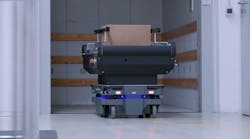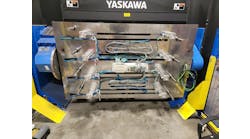Kenneth Bruun Henriksen is the global head of MiR Go Ecosystem and a board member of Aim Robotics. He shared his thoughts on robot integration.
What innovative or efficient robot-integration applications have you seen or been involved with?
Kenneth Bruun Henriksen, global head of MiR Go Ecosystem: The integration into other work cells is a key feature of autonomous mobile robots (AMRs). Common integration areas are to connect directly to the work cell and pick up parts with, for example, conveyor top modules. But moreover end-of-line palletizing where the AMRs connect to the palletizers is also a use case that’s increasing.
In the electronics sector especially, there’s also an increased focus on integrating mobile manipulators, with a mobile robot and a collaborative mobile arm. Collaborative mobile robots have been used for machine tending for some years now, but they can become more productive and versatile by adding mobility.
What have been the biggest improvements to robot integration and interoperability with other robots or components in work cells in the past five years?
Additionally, the rise of collaborative robots and AMRs have also prompted the integration, as these are made not just to collaborate with humans but also by nature being flexible and easy to deploy into other systems. This has opened up the idea of using robots in areas where it has been impossible until a few years ago.
As manufacturers and warehouses/distribution centers push toward autonomous operations, what is the benefit of collaborative robots (cobots) and their ability to work alongside humans?
Kenneth Bruun Henriksen, global head of MiR Go Ecosystem: Cobots and AMRs offer many valuable contributions: cobots and AMRs work alongside human employees, increasing overall productivity by handling repetitive tasks and assisting with material transport, allowing humans to focus on more complex activities. These robots are easy to program and adaptable to changing tasks and environments, making them ideal for dynamic operations. Compared to traditional robot systems, cobots and AMRs are cost-efficient. Integrating AMRs and cobots requires less infrastructure and setup time, even when connecting to other existing systems.
At the same time, they improve workplace safety and create more attractive workplaces. Cobots and AMRs are equipped with advanced safety features, ensuring they can work safely near humans, reducing the risk of accidents and injuries. Moreover, they handle physically demanding tasks, reducing the physical strain on human workers and decreasing the risk of workplace-related injuries and fatigue.
By complementing human skills, the robots enhance productivity without replacing workers. Studies show that implementing AMRs not only makes a more productive workplace that allows the company to actually hire more people, but also makes the workplace more attractive because people at any level would like to work with robots, which in today’s labor market is a valuable asset.
When will robotics technology become user-friendly enough that integration, installation and operation is plug-and-play and no longer requires extensive engineering?
Kenneth Bruun Henriksen, global head of MiR Go Ecosystem: We are working toward it, and both AMRs and cobots are a step closer to plug-and-play. But while deploying single AMRs and cobots are simple and can be done easily, complexity increases when you want different robots and systems to integrate. Interoperability is a key focus for most robotics manufacturers and in some future we will see more simple solutions, for even complex installations. However, there’s currently also a skills gap, and companies need in-house engineers that are used to working with robots to take ownership of the integration.
What future innovations will impact the integration of robotics technology in work cells and with other industrial machinery?
Kenneth Bruun Henriksen, global head of MiR Go Ecosystem: There’s ongoing work as AMRs and cobots are made to integrate with other systems easily. Moreover, interoperability and third-party fleet systems that can integrate different robotics systems will affect ease of integration a lot.
Artificial intelligence (AI), of course, is also a hot topic that in time will impact integrations. For AMRs, the technology means smarter robots that can teach themselves how to perform tasks that were previously difficult or impossible without expensive and time-intensive coding. Advanced AMRs rely on AI for capabilities such as identifying objects with greater precision and informing navigation for safe maneuvering through busy facilities, all with less power consumption. And while huge jumps in AI capabilities are still to come, the autonomous behavior of AMRs—how they get from one point to another without truly knowing what goes on around them—will continue to improve.
5G will also impact robotic integrations. More companies are transitioning away from Wi-Fi connectivity to 4G, a big leap toward the stronger and more-robust IT infrastructure. Even with 4G, facilities will see better data connectivity, enhanced security and a much higher overall quality of service than what is offered with traditional Wi-Fi. As enterprises ultimately transition to 5G, they will benefit from the ultra-reliable and ultra-fast high-bandwidth communication that 5G offers.
Once 5G is widely deployed, its stronger and more robust IT infrastructure will be a game changer for robots, enabling companies to efficiently deploy and manage dozens or even hundreds of robots. 5G offers ultra-reliable and ultra-fast high-bandwidth communication, providing the stability to deploy multiple robots running without interruption.
Editor’s note: Ericsson has been using 5G communication for AMRs in its Ericsson USA 5G Smart Factory in Lewisville, Texas. Per Treven explains its impact on smart manufacturing in this article.
Tell us about your company’s state-of-the-art robotic integration into a work cell or transporting materials/goods between cells.
Kenneth Bruun Henriksen, global head of MiR Go Ecosystem: In general, transporting VIP parts and components between work cells is a major application for MiR robots. Our MiR250 robots are often deployed with karakuri systems or conveyors as top modules to connect seamlessly to the existing work cell.
The new light conveyor platform (LCP) from Interroll is a good example of the state-of-the-art complete integration of our robots and a top module that can automate the internal transportation within a manufacturing area completely. The Interroll top module is a MiR Go-certified top module, which means that it is tested and verified by MIR, and therefore, it is an industrial, ready-to-use solution for companies that are looking to move from manual transportation to automatic transportation between the less flexible conveyors.
MiR’s larger robots, MiR600 and MiR1350, often drive from work cells in the production with pallets to other work cells in the logistics area. These robots can interface with palletizers, strapping machines and conveyors to automate the pallet handling.
As industrial robot installations continue to rise, they continue to be integrated into work cells for palletizing, machine tending, welding and other industrial applications.






